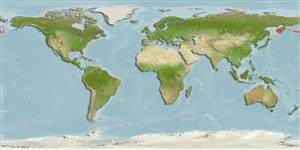Lớp phụ Cá sụn (cá mập và cá đuối) (sharks and rays) >
Rajiformes (Skates and rays) >
Arhynchobatidae (Softnose skates)
Etymology: Bathyraja: Greek, bathys = deep + Latin, raja, -ae = a ray (Raja sp) (Ref. 45335); maculata: Name from the Latin adjective 'maculata' meaning blotched, referring to the color markings on the dorsal side of the disc.
Environment: milieu / climate zone / Mức độ sâu / distribution range
Sinh thái học
Biển Tầng đáy biển sâu; Mức độ sâu 70 - 1200 m (Ref. 131164), usually 400 - 700 m (Ref. 131164). Deep-water; 2°C - 6°C (Ref. 131164); 59°N - 51°N
North Pacific: southern Sea of Okhotsk to the eastern Gulf of Alaska, including the Bering Sea, the waters off the Kuril and Aleutian Islands, and eastern Kamchatka.
Length at first maturity / Bộ gần gũi / Khối lượng (Trọng lượng) / Age
Chín muồi sinh dục: Lm 97.5, range 94 - 101 cm
Max length : 134 cm TL con đực/không giới tính; (Ref. 52075); Khối lượng cực đại được công bố: 8.5 kg (Ref. 56527)
Short description
Khóa để định loại | Hình thái học | Sinh trắc học
This species is distinguished from its congeners Bathyraja in having a white blotches of different sizes on the dorsal surface of the disk, lateral folds of tail are broad; clasper has a large pseudosiphon; dense silky fibers covering egg capsule (Ref. 75535).
Body shape (shape guide): other.
Exhibited migratory pattern of going toward greater depths during colder months for overwintering, while in the warm period, this species predominantly fed at shallower depths Oviparous. Distinct pairing with embrace. Young may tend to follow large objects, such as their mother (Ref. 205). Eggs are oblong capsules with stiff pointed horns at the corners deposited in sandy or muddy flats (Ref. 205). Egg capsules are 10.19 cm long and 6.28 cm wide (Ref. 41249).
Oviparous, paired eggs are laid. Embryos feed solely on yolk (Ref. 50449). Distinct pairing with embrace. Young may tend to follow large objects, such as their mother (Ref. 205).
McEachran, J.D. and K.A. Dunn, 1998. Phylogenetic analysis of skates, a morphologically conservative clade of elasmobranchs (Chondrichthyes: Rajidae). Copeia 1998(2):271-290. (Ref. 27314)
IUCN Red List Status (Ref. 130435: Version 2024-2)
Threat to humans
Harmless
Human uses
Các nghề cá: bycatch
Các công cụ
Special reports
Download XML
Các nguồn internet
Estimates based on models
Preferred temperature (Tài liệu tham khảo
123201): 1.3 - 3.8, mean 2 °C (based on 27 cells).
Phylogenetic diversity index (Tài liệu tham khảo
82804): PD
50 = 0.5000 [Uniqueness, from 0.5 = low to 2.0 = high].
Bayesian length-weight: a=0.00331 (0.00285 - 0.00385), b=3.10 (3.06 - 3.14), in cm total length, based on LWR estimates for this species (Ref.
93245).
Mức dinh dưỡng (Tài liệu tham khảo
69278): 4.1 ±0.71 se; based on food items.
Generation time: 30.5 ( na - na) years. Estimated as median ln(3)/K based on 1
growth studies.
Thích nghi nhanh (Tài liệu tham khảo
120179): thấp, thời gian nhân đôi của chủng quần tối thiểu là 4.5 - 14 năm (Fec assumed to be <100).
Fishing Vulnerability (Ref.
59153): Very high vulnerability (80 of 100).
🛈
